Spatiotemporal Patterns of Ammonia Nitrogen and Chemical Oxygen Demand in the Huaihe River–Hongze Lake System (Eastern China)
Abstract
:1. Introduction
2. Material and Methods
2.1. Study Region
2.2. Data
2.3. Methods
3. Results
3.1. Long-Term Trends of Streamflow and Water Quality
3.2. Variability in Streamflow and Annual Water Quality
3.3. Temporal Patterns and Periodicities
4. Discussion
4.1. The Impacts of Streamflow on Contaminant Transport Regimes
4.2. The Impacts of Water Temperature on Water Quality Variability
4.3. The Impacts of Land Use on Water Quality Variability
4.4. Particularity of Water Quality Patterns in a River–Lake System
5. Conclusions
Author Contributions
Funding
Data Availability Statement
Conflicts of Interest
References
- Wang, G.; Li, J.; Sun, W.; Xue, B.; Yinglan, A.; Liu, T. Non-Point Source Pollution Risks in a Drinking Water Protection Zone Based on Remote Sensing Data Embedded within a Nutrient Budget Model. Water Res. 2019, 157, 238–246. [Google Scholar] [CrossRef] [PubMed]
- Han, Q.; Tong, R.; Sun, W.; Zhao, Y.; Yu, J.; Wang, G.; Shrestha, S.; Jin, Y. Anthropogenic Influences on the Water Quality of the Baiyangdian Lake in North China over the Last Decade. Sci. Total Environ. 2020, 701, 134929. [Google Scholar] [CrossRef] [PubMed]
- Yuan, S.; Tang, H.; Li, K.; Xu, L.; Xiao, Y.; Gualtieri, C.; Rennie, C.; Melville, B. Hydrodynamics, Sediment Transport and Morphological Features at the Confluence between the Yangtze River and the Poyang Lake. Water Resour. Res. 2021, 57, e2020WR028284. [Google Scholar] [CrossRef]
- Yuan, S.; Xu, L.; Tang, H.; Xiao, Y.; Gualtieri, C. The Dynamics of River Confluences and Their Effects on the Ecology of Aquatic Environment: A Review. J. Hydrodyn. 2022, 34, 1–14. [Google Scholar] [CrossRef]
- Zhao, C.; Liu, C.; Xia, J.; Zhang, Y.; Yu, Q.; Eamus, D. Recognition of Key Regions for Restoration of Phytoplankton Communities in the Huai River Basin, China. J. Hydrol. 2012, 420–421, 292–300. [Google Scholar] [CrossRef]
- Yang, X.; Liu, Q.; Fu, G.; He, Y.; Luo, X.; Zheng, Z. Spatiotemporal Patterns and Source Attribution of Nitrogen Load in a River Basin with Complex Pollution Sources. Water Res. 2016, 94, 187–199. [Google Scholar] [CrossRef] [PubMed] [Green Version]
- Zhai, X.; Xia, J.; Zhang, Y. Integrated Approach of Hydrological and Water Quality Dynamic Simulation for Anthropogenic Disturbance Assessment in the Huai River Basin, China. Sci. Total Environ. 2017, 598, 749–764. [Google Scholar] [CrossRef] [PubMed]
- Xu, J.; Jin, G.; Tang, H.; Zhang, P.; Wang, S.; Wang, Y.-G.; Li, L. Assessing Temporal Variations of Ammonia Nitrogen Concentrations and Loads in the Huaihe River Basin in Relation to Policies on Pollution Source Control. Sci. Total Environ. 2018, 642, 1386–1395. [Google Scholar] [CrossRef]
- Ouyang, Y.; Nkedi-Kizza, P.; Wu, Q.; Shinde, D.; Huang, C. Assessment of Seasonal Variations in Surface Water Quality. Water Res. 2006, 40, 3800–3810. [Google Scholar] [CrossRef]
- Walker, D.; Jakovljevic, D.; Savic, D.; Radovanovic, M. Multi-Criterion Water Quality Analysis of the Danube River in Serbia: A Visualisation Approach. Water Res. 2015, 79, 158–172. [Google Scholar] [CrossRef]
- Lutz, S.R.; Mallucci, S.; Diamantini, E.; Majone, B.; Bellin, A.; Merz, R. Hydroclimatic and Water Quality Trends across Three Mediterranean River Basins. Sci. Total Environ. 2016, 571, 1392–1406. [Google Scholar] [CrossRef] [PubMed] [Green Version]
- Ferreira, D.; Fernandes, C.; Kaviski, E.; Fontane, D. Transformation Rates of Pollutants in Rivers for Water Quality Modelling under Unsteady State: A Calibration Method. J. Hydrol. 2020, 585, 124769. [Google Scholar] [CrossRef]
- Yang, C.; Daigger, G.; Belia, E.; Kerkez, B. Extracting Useful Signals from Flawed Sensor Data: Developing Hybrid Data-Driven Approaches with Physical Factors. Water Res. 2020, 185, 116282. [Google Scholar] [CrossRef] [PubMed]
- Diamantini, E.; Lutz, S.R.; Mallucci, S.; Majone, B.; Merz, R.; Bellin, A. Driver Detection of Water Quality Trends in Three Large European River Basins. Sci. Total Environ. 2018, 612, 49–62. [Google Scholar] [CrossRef]
- Panthi, J.; Li, F.; Wang, H.; Aryal, S.; Dahal, P.; Ghimire, S.; Kabenge, M. Evaluating Climatic and Non-Climatic Stresses for Declining Surface Water Quality in Bagmati River of Nepal. Environ. Monit. Assess. 2017, 189, 1–15. [Google Scholar] [CrossRef]
- Mannina, G.; Viviani, G. Water Quality Modelling for Ephemeral Rivers: Model Development and Parameter Assessment. J. Hydrol. 2010, 393, 186–196. [Google Scholar] [CrossRef]
- Qiu, Y.; Xie, H.; Sun, J.; Duan, H. A Novel Spatiotemporal Data Model for River Water Quality Visualization and Analysis. IEEE Access 2019, 7, 155455–155461. [Google Scholar] [CrossRef]
- Qu, X.; Chen, Y.; Liu, H.; Xia, W.; Lu, Y.; Gang, D.; Lin, L. A Holistic Assessment of Water Quality Condition and Spatiotemporal Patterns in Impounded Lakes along the Eastern Route of China’s South-to-North Water Diversion Project. Water Res. 2020, 185, 116275. [Google Scholar] [CrossRef]
- Tian, Y.; Wen, Z.; Cheng, M.; Xu, M. Evaluating the Water Quality Characteristics and Tracing the Pollutant Sources in the Yellow River Basin, China. Sci. Total Environ. 2022, 846, 157389. [Google Scholar] [CrossRef]
- Al-Ghorani, N.G.; Hassan, M.A.; Langendoen, E.J. Spatiotemporal Patterns of Fractional Suspended Sediment Dynamics in Small Watersheds. Water Resour. Res. 2021, 57, e2021WR030851. [Google Scholar] [CrossRef]
- Li, Y.; Zhu, X. Periodic Identification of Runoff in Hei River Based on Predictive Extension Method of Eliminating the Boundary Effect of the Wavelet Transform. J. Hydrol. Eng. 2021, 26, 05021008. [Google Scholar] [CrossRef]
- Santos, C.; Ideiao, S. Application of the Wavelet Transform for Analysis of Precipitation and Runoff Time Series. Predict. Ungauged Basins Promise Prog. 2006, 303, 431–439. [Google Scholar]
- Labat, D.; Ronchail, J.; Callede, J.; Guyot, J.; De Oliveira, E.; Guimaraes, W. Wavelet Analysis of Amazon Hydrological Regime Variability. Geophys. Res. Lett. 2004, 31, L02501. [Google Scholar] [CrossRef] [Green Version]
- Jiang, C.; Zhou, J.; Wang, J.; Fu, G.; Zhou, J. Characteristics and Causes of Long-Term Water Quality Variation in Lixiahe Abdominal Area, China. Water 2020, 12, 1694. [Google Scholar] [CrossRef]
- Yan, J.; Hu, Y. An Analysis Method of Water Quality Influencing Factors Based on Wavelet Transform. In Proceedings of the 2021 2nd International Conference on Artificial Intelligence and Information Systems, Chongqing China, 28–30 May 2021. [Google Scholar] [CrossRef]
- Lin, C.A.; Wen, L.; Lu, G.; Wu, Z.; Zhang, J.; Yang, Y.; Zhu, Y.; Tong, L. Real-Time Forecast of the 2005 and 2007 Summer Severe Floods in the Huaihe River Basin of China. J. Hydrol. 2010, 381, 33–41. [Google Scholar] [CrossRef]
- Dou, M.; Zhang, Y.; Li, G. Temporal and Spatial Characteristics of the Water Pollutant Concentration in Huaihe River Basin From2003 to 2012, China. Environ. Monit. Assess. 2016, 188, 522. [Google Scholar] [CrossRef] [PubMed]
- Zhang, C.; Wang, L.; Zhu, H.; Tang, H. Integrated Hydrodynamic Model for Simulation of River-Lake-Sluice Interactions. Appl. Math. Model. 2020, 83, 90–106. [Google Scholar] [CrossRef]
- Liu, H.; Bao, A.; Chen, X.; Wang, L.; Pan, X. Response Analysis of Rainfall-Runoff Processes Using Wavelet Transform: A Case Study of the Alpine Meadow Belt. Hydrol. Process. 2011, 25, 2179–2187. [Google Scholar] [CrossRef]
- Hamed, K.; Rao, A. A Modified Mann-Kendall Trend Test for Autocorrelated Data. J. Hydrol. 1998, 204, 182–196. [Google Scholar] [CrossRef]
- Cavadias, G.; Yue, S.; Pilon, P. Power of the Mann-Kendall and Spearman’s Rho Tests for Detecting Monotonic Trends in Hydrological Series. J. Hydrol. 2002, 259, 254–271. [Google Scholar]
- Sen, P.K. Estimates of the Regression Coefficient Based on Kendall’s Tau. J. Am. Stat. Assoc. 1968, 63, 1379–1389. [Google Scholar] [CrossRef]
- Torrence, C.; Compo, G. A Practical Guide to Wavelet Analysis. Bull. Am. Meteorol. Soc. 1998, 79, 61–78. [Google Scholar] [CrossRef]
- Grinsted, A.; Moore, J.; Jevrejeva, S. Application of the Cross Wavelet Transform and Wavelet Coherence to Geophysical Time Series. Nonlinear Process. Geophys. 2004, 11, 561–566. [Google Scholar] [CrossRef]
- Cazelles, B.; Chavez, M.; Berteaux, D.; Menard, F.; Vik, J.; Jenouvrier, S.; Stenseth, N. Wavelet Analysis of Ecological Time Series. Oecologia 2008, 156, 287–304. [Google Scholar] [CrossRef]
- Wu, Y.; Dai, R.; Xu, Y.; Han, J.; Li, P. Statistical Assessment of Water Quality Issues in Hongze Lake, China, Related to the Operation of a Water Diversion Project. Sustainability 2018, 10, 1885. [Google Scholar] [CrossRef] [Green Version]
- Mooney, D.; Richards, K.G.; Danaher, M.; Grant, J.; Gill, L.; Mellander, P.-E.; Coxon, C.E. An Analysis of the Spatio-Temporal Occurrence of Anthelmintic Veterinary Drug Residues in Groundwater. Sci. Total Environ. 2021, 769, 144804. [Google Scholar] [CrossRef]
- Murphy, J.; Sprague, L. Water-Quality Trends in US Rivers: Exploring Effects from Streamflow Trends and Changes in Watershed Management. Sci. Total Environ. 2019, 656, 645–658. [Google Scholar] [CrossRef]
- van Vliet, M.; Zwolsman, J. Impact of Summer Droughts on the Water Quality of the Meuse River. J. Hydrol. 2008, 353, 1–17. [Google Scholar] [CrossRef]
- Wolff, E.; van Vliet, M. Impact of the 2018 Drought on Pharmaceutical Concentrations and General Water Quality of the Rhine and Meuse Rivers. Sci. Total Environ. 2021, 778, 146182. [Google Scholar] [CrossRef]
- Alvarez-Cabria, M.; Barquin, J.; Penas, F. Modelling the Spatial and Seasonal Variability of Water Quality for Entire River Networks: Relationships with Natural and Anthropogenic Factors. Sci. Total Environ. 2016, 545, 152–162. [Google Scholar] [CrossRef]
- Yang, K.; Yu, Z.; Luo, Y.; Yang, Y.; Zhao, L.; Zhou, X. Spatial and Temporal Variations in the Relationship between Lake Water Surface Temperatures and Water Quality—A Case Study of Dianchi Lake. Sci. Total Environ. 2018, 624, 859–871. [Google Scholar] [CrossRef] [PubMed]
- Li, Y.; Zang, C.; Chen, X. Research on temporal and spatial variation characteristics and driving mechanism of land use in Huaihe River Basin from 1990 to 2015. Ecol. Sci. 2020, 39, 104. (In Chinese) [Google Scholar] [CrossRef]
- Tu, J. Combined Impact of Climate and Land Use Changes on Streamflow and Water Quality in Eastern Massachusetts, USA. J. Hydrol. 2009, 379, 268–283. [Google Scholar] [CrossRef]
- Meneses, B.; Reis, R.; Vale, M.; Saraiva, R. Land Use and Land Cover Changes in Zezere Watershed (Portugal)—Water Quality Implications. Sci. Total Environ. 2015, 527, 439–447. [Google Scholar] [CrossRef]
- Zhang, T.; Feng, M.; Chen, K.; Cai, Y. Spatiotemporal Distributions and Mixing Dynamics of Characteristic Contaminants at a Large Asymmetric Confluence in Northern China. J. Hydrol. 2020, 591, 125583. [Google Scholar] [CrossRef]
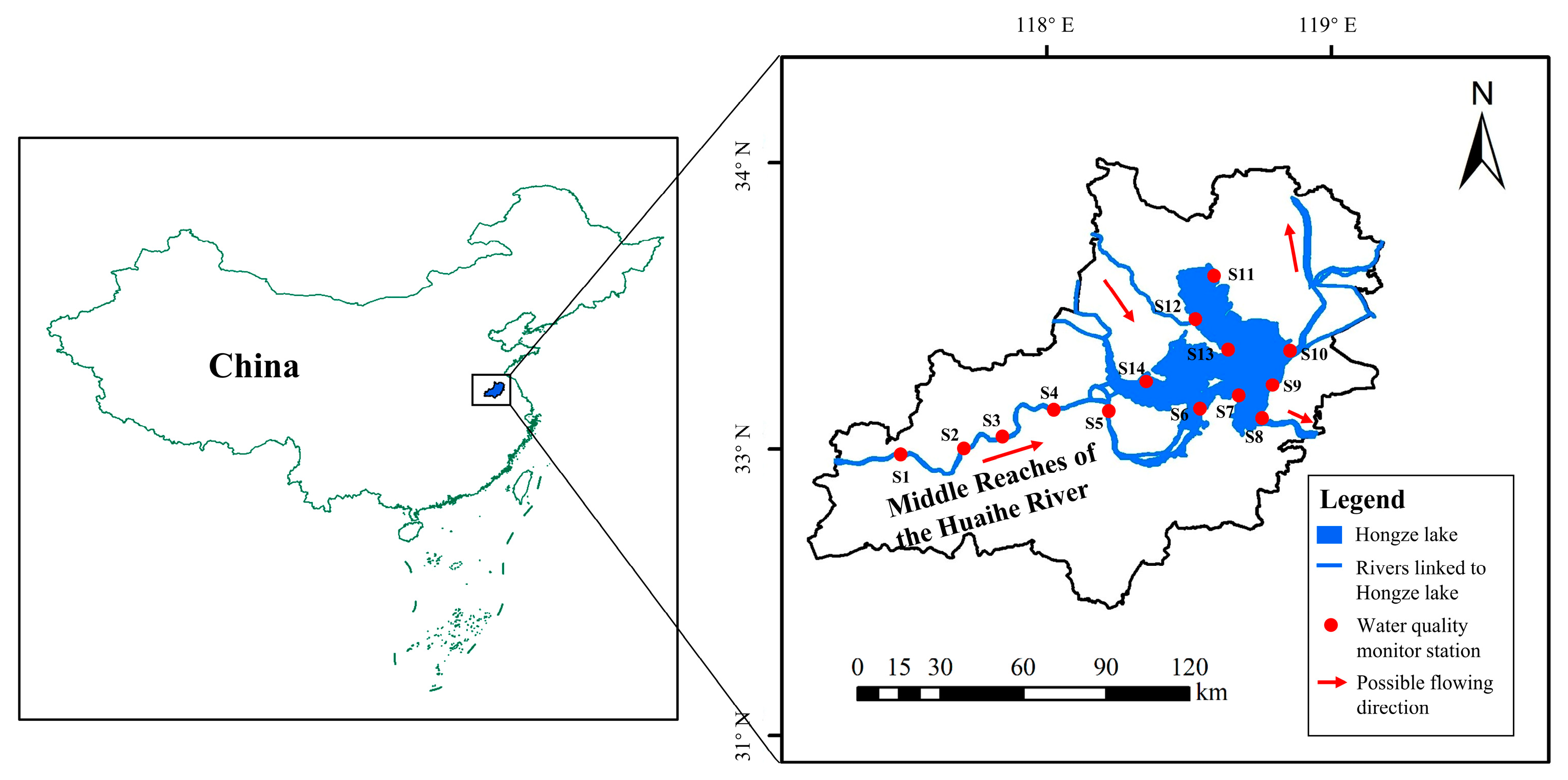
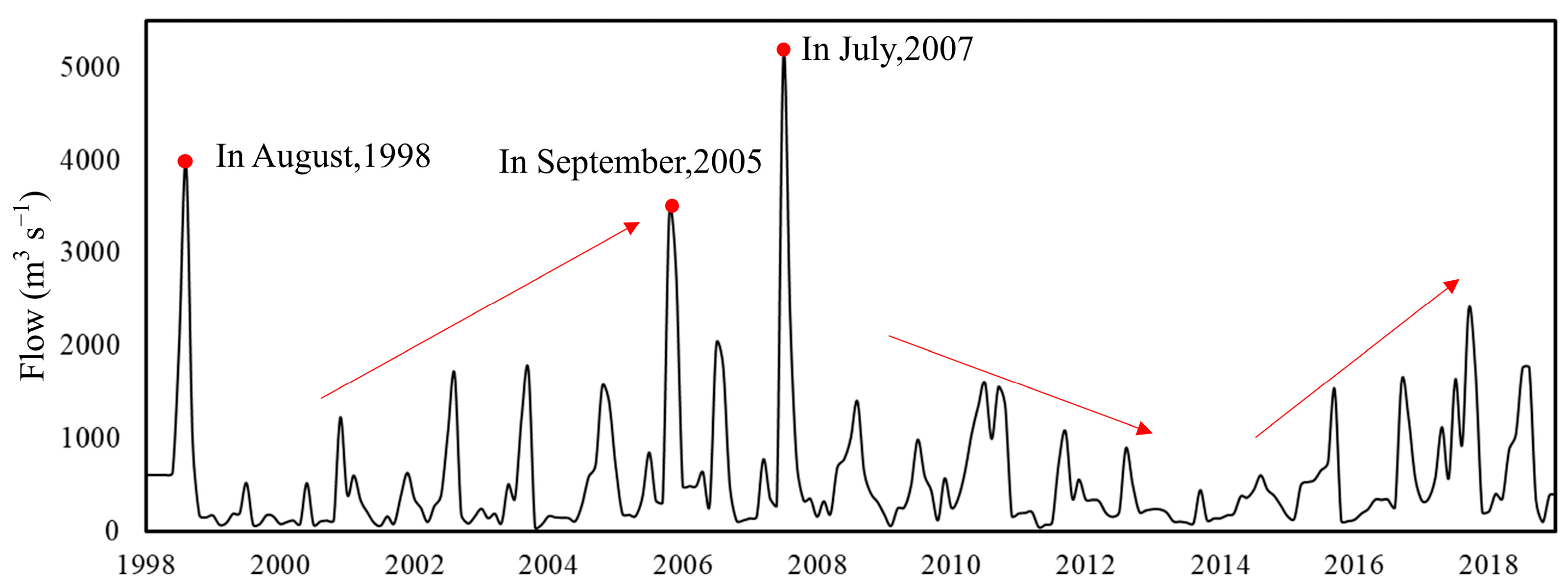


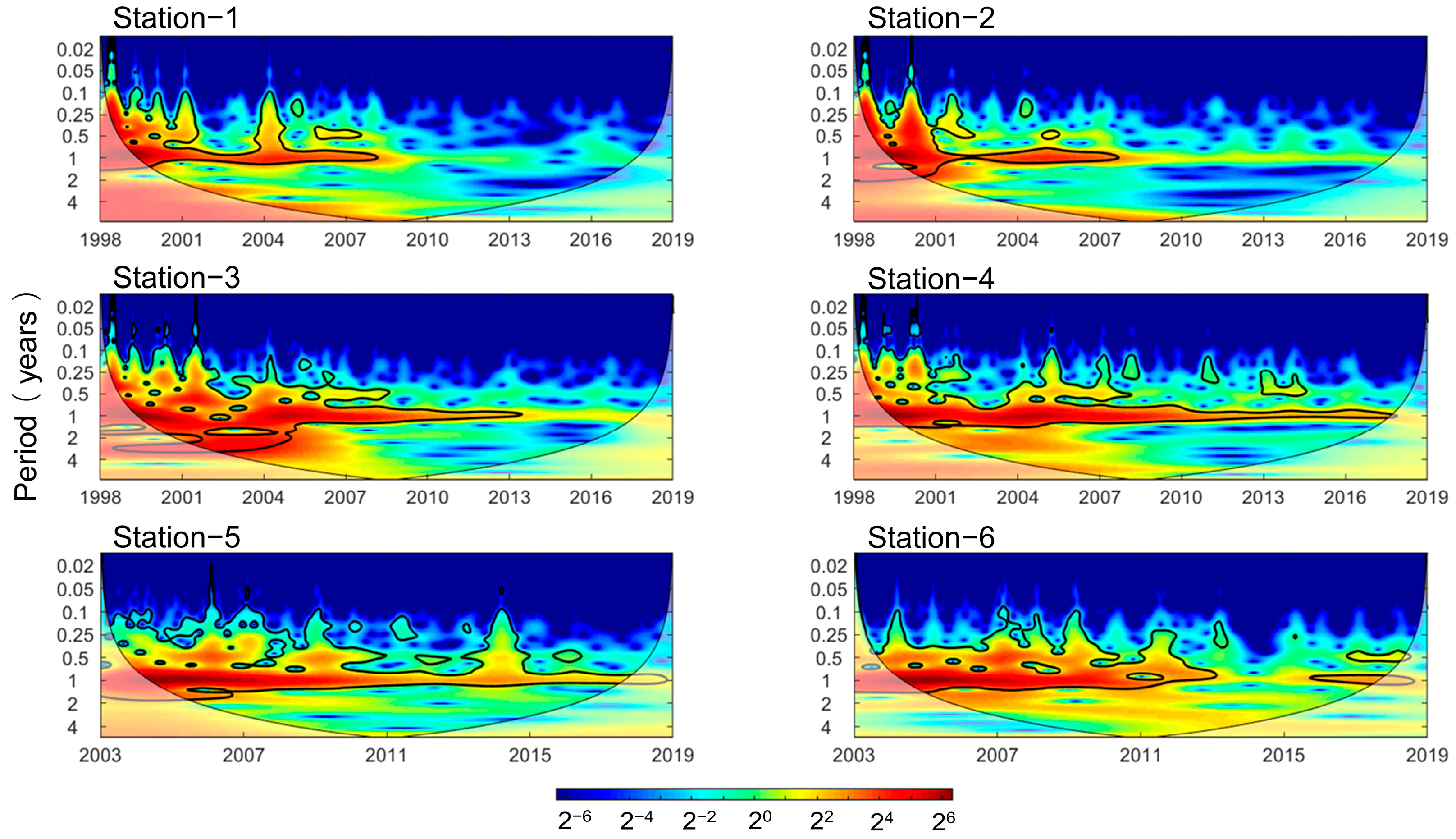
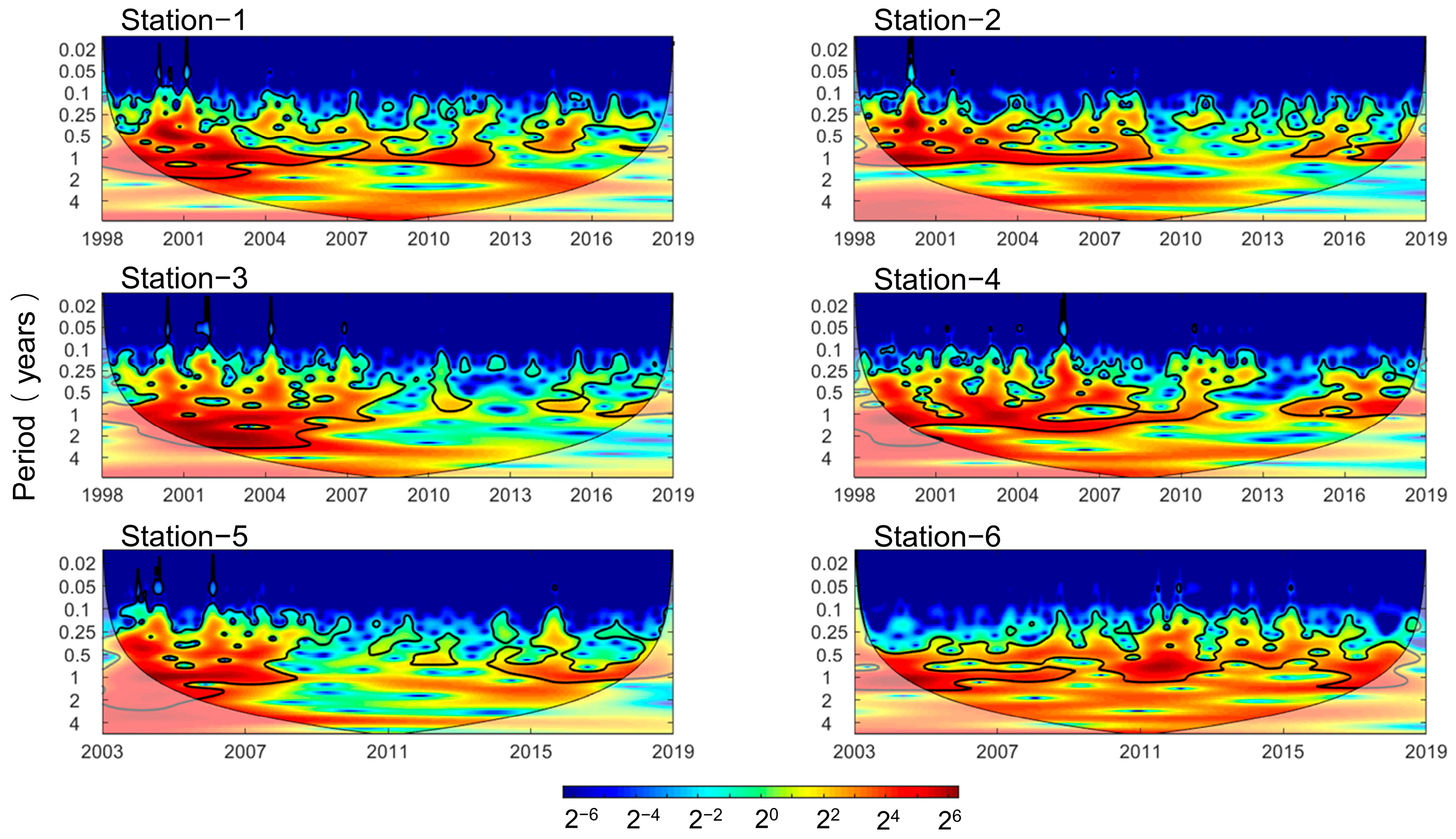



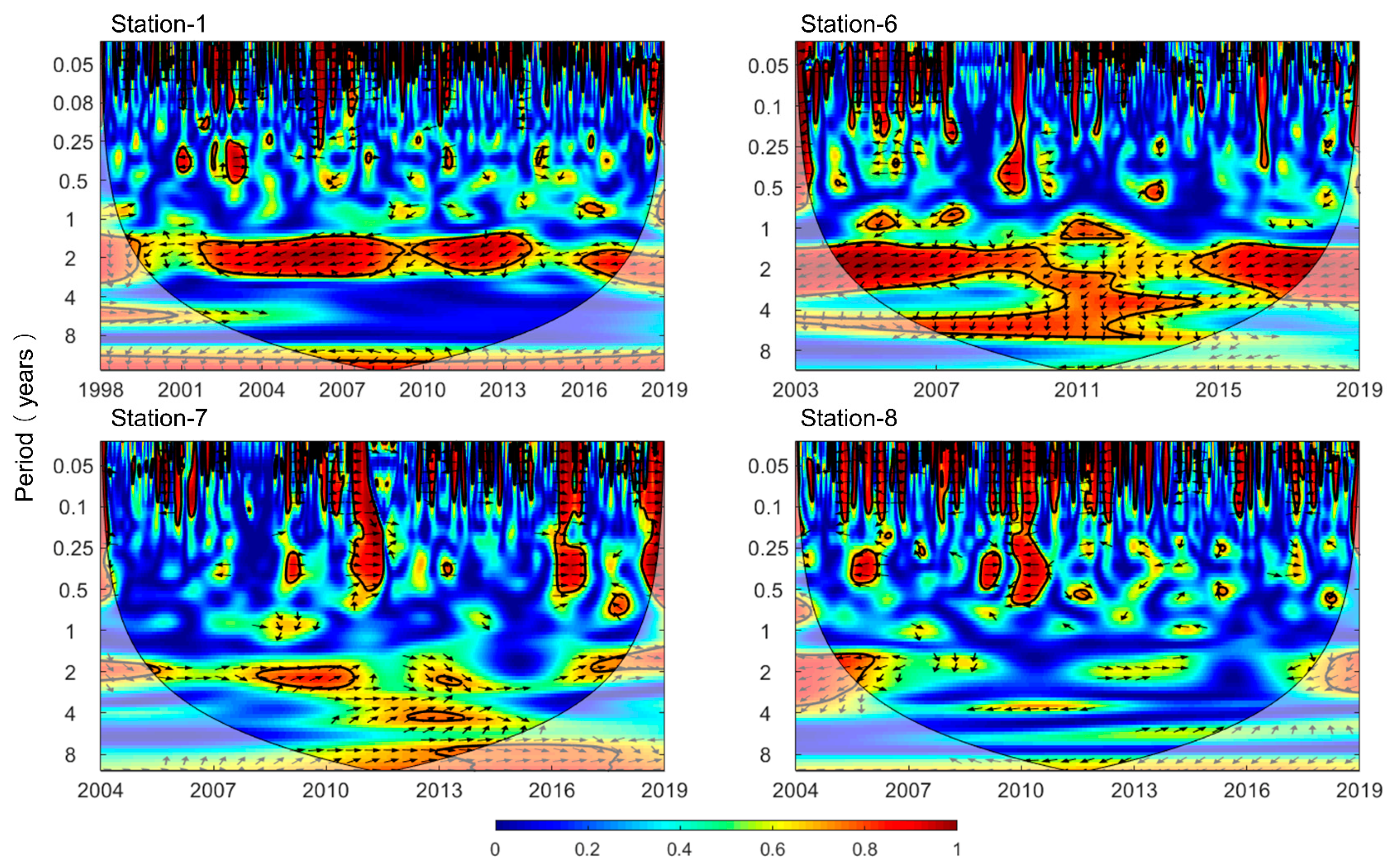

| Station ID | Station Name | Location | Monitoring Period |
|---|---|---|---|
| S1 | Lu Taizi | HR | January 1998–December 2018 |
| S2 | Beng Bu | HR | January 1998–December 2018 |
| S3 | Wu Jiadu | HR | January 1998–December 2018 |
| S4 | Lin Huaiguan | HR | January 1998–December 2018 |
| S5 | Xiao Liuxiang | HR | January 2003–December 2018 |
| S6 | Lao Zishan | HR | January 2003–December 2018 |
| S7 | Lin Huai | HL | January 2004–December 2018 |
| S8 | Jiang Ba | HL | January 2004–December 2018 |
| S9 | Gao Liangjian | HL | January 2004–December 2018 |
| S10 | Er Hezha | HL | January 2004–December 2018 |
| S11 | Cheng Zihu | HL | January 2004–December 2018 |
| S12 | Xu Hong | HL | January 2004–December 2018 |
| S13 | Cheng He | HL | January 2004–December 2018 |
| S14 | Li Hewa | HL | January 2004–December 2018 |
| Ammonia Nitrogen | Chemical Oxygen Demand | ||||||
|---|---|---|---|---|---|---|---|
| Mann–Kendall Test | Mann–Kendall Test | ||||||
| Station ID | Mean Annual Flow (m3 s−1) | Mean (mg L−1) | Z Stat | Sen’s Slope (mg L−1 year−1) | Mean (mg L−1) | Z Stat | Sen’s Slope (mg L−1 year−1) |
| 1 | 554 ± 612 | 0.76 ± 1.48 | −4.37 * | −0.043 | 4.37 ± 1.35 | −3.54 * | −0.097 |
| 2 | 817 ± 916 | 0.89 ± 1.76 | −4.39 * | −0.064 | 4.04 ± 0.99 | −4.25 * | −0.083 |
| 3 | 778 ± 930 | 1.09 ± 1.24 | −5.35 * | −0.077 | 4.61 ± 1.55 | −3.79 * | −0.127 |
| 4 | 775 ± 933 | 0.92 ± 1.06 | −5.41 * | −0.069 | 4.18 ± 0.98 | −3.21 * | −0.074 |
| 5 | 886 ± 1127 | 0.84 ± 0.97 | −4.27 * | −0.101 | 4.20 ± 1.17 | −2.29 * | −0.106 |
| 6 | 805 ± 1019 | 0.45 ± 0.47 | −4.36 * | −0.049 | 3.78 ± 0.51 | 1.68 ** | 0.004 |
| Ammonia Nitrogen | Chemical Oxygen Demand | |||||
|---|---|---|---|---|---|---|
| Mann–Kendall Test | Mann–Kendall Test | |||||
| Station ID | Mean (mg L−1) | Z Stat | Sen’s Slope (mg L−1 y−1) | Mean (mg L−1) | Z Stat | Sen’s Slope (×10−3 y−1) |
| 7 | 0.26 ± 0.22 | −2.37 * | −0.014 | 3.71 ± 0.62 | −1.97 * | −0.104 |
| 8 | 0.29 ± 0.15 | −3.06 * | −0.016 | 4.62 ± 0.88 | 1.78 ** | 0.024 |
| 9 | 0.25 ± 0.20 | −3.76 * | −0.021 | 3.79 ± 0.53 | 1.23 | 0.003 |
| 10 | 0.34 ± 0.37 | −3.07 * | −0.024 | 3.86 ± 1.69 | −0.98 | −0.001 |
| 11 | 0.26 ± 0.18 | −1.78 ** | −0.008 | 2.51 ± 0.68 | −2.17 * | −0.056 |
| 12 | 0.58 ± 1.69 | −0.69 | −0.011 | 3.89 ± 0.84 | 0.01 | 0.001 |
| 13 | 0.27 ± 0.12 | −1.48 | −0.005 | 4.32 ± 1.31 | −2.78 * | −0.101 |
| 14 | 0.26 ± 0.21 | −2.67 * | −0.019 | 3.41 ± 0.58 | 0.21 | 0.003 |
| Land-Use Type | 1995–2000 | 2000–2005 | 2005–2010 | 2010–2015 |
|---|---|---|---|---|
| Construction | 1069 | 1598 | 1565 | 1652 |
| Cultivated | −71 | −1724 | −1687 | −1706 |
| Water | 497 | 424 | 42 | 19 |
| Pasture | −29 | −107 | −19 | −21 |
| Forest | −1465 | −110 | 51 | 14 |
Disclaimer/Publisher’s Note: The statements, opinions and data contained in all publications are solely those of the individual author(s) and contributor(s) and not of MDPI and/or the editor(s). MDPI and/or the editor(s) disclaim responsibility for any injury to people or property resulting from any ideas, methods, instructions or products referred to in the content. |
© 2023 by the authors. Licensee MDPI, Basel, Switzerland. This article is an open access article distributed under the terms and conditions of the Creative Commons Attribution (CC BY) license (https://creativecommons.org/licenses/by/4.0/).
Share and Cite
Han, J.; Xu, J.; Chen, H.; Xu, P.; Wang, L. Spatiotemporal Patterns of Ammonia Nitrogen and Chemical Oxygen Demand in the Huaihe River–Hongze Lake System (Eastern China). Water 2023, 15, 2157. https://doi.org/10.3390/w15122157
Han J, Xu J, Chen H, Xu P, Wang L. Spatiotemporal Patterns of Ammonia Nitrogen and Chemical Oxygen Demand in the Huaihe River–Hongze Lake System (Eastern China). Water. 2023; 15(12):2157. https://doi.org/10.3390/w15122157
Chicago/Turabian StyleHan, Jianjun, Jin Xu, Han Chen, Pengcheng Xu, and Lingling Wang. 2023. "Spatiotemporal Patterns of Ammonia Nitrogen and Chemical Oxygen Demand in the Huaihe River–Hongze Lake System (Eastern China)" Water 15, no. 12: 2157. https://doi.org/10.3390/w15122157
APA StyleHan, J., Xu, J., Chen, H., Xu, P., & Wang, L. (2023). Spatiotemporal Patterns of Ammonia Nitrogen and Chemical Oxygen Demand in the Huaihe River–Hongze Lake System (Eastern China). Water, 15(12), 2157. https://doi.org/10.3390/w15122157






